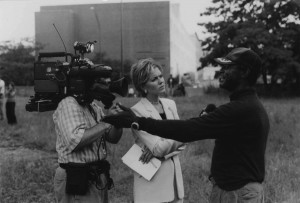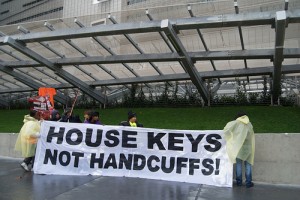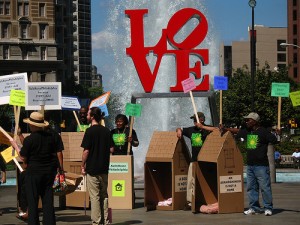Hardball history: Knowing the people's history requires being on their side
09 April 2015 – Dan Kerr
conference, ethics, advocacy, Hardball History, methods, social justice, community history, publicity, collaboration, human rights, gentrification, politics

Project narrator David Campbell explains to the media in August 2002 why he will not leave his encampment, known as Camelot, while the city bulldozers wait to move in. Photo credit: Steve Cagan. Used with permission from the collection of the Northeast Ohio Coalition for the Homeless.
On May 30, 1995, wearing an orange construction helmet, I stood behind a makeshift barricade on E. 13th Street in New York City. Hundreds of squatters faced off against larger numbers of riot police who were armed with a tank and supported by snipers on the surrounding buildings. They had come to evict people from five buildings, and as they moved in, we locked arms to prevent them from gaining entrance. One by one they arrested us and dragged us away as the media reported the event live throughout the day. While we lost the buildings and over one hundred people lost their homes, the action paved the way for the remaining squats in the neighborhood to become legally recognized.
We had a sense we were making history, putting our mark on a long tradition of radical activism in the community. It was a history told though stories on park benches; documented in old photographs; archived in personal collections of dog-eared papers, yellowed flyers, and ‘zines; and memorialized with graffiti and punk anthems. The history was sustained by the elders, who had little materially to show from life, but captivated the attention of irreverent younger people who affectionately heard their stories as a boast and a challenge. To make history, we needed to know the history. Knowing the history necessitated knowing the people and knowing the people required being on their side.
After spending two years as a squatter activist, when the smoke and dust cleared from the 13th Street struggles, I moved on to Cleveland, Ohio. Continuing to focus my attention on issues related to homelessness, I founded the local chapter of Food Not Bombs in January 1996. Several people approached me and asked if I would organize housing takeovers, as we had done in New York. While I did conduct workshops on squatting, I was more interested in understanding how unhoused people in the city defined their own circumstances. For them, what were the important issues and themes that needed to be addressed? What strategies did they think were most effective? This shift away from telling people what needed to be done towards asking them what they thought should be done signaled a personal move away from activism towards an embrace of popular education.

A 2010 protest over the federal government’s inaction on housing issues at the San Francisco federal building. Photo credit: Steve Rhodes
After spending every Sunday afternoon for three years sharing food on Cleveland’s Public Square, I began videotaping interviews for what would become the Cleveland Homeless Oral History Project. As they finished their meals, I asked the narrators to explain what led to the rise of homelessness in the city. I deliberately steered clear of the life history approach and opened up the opportunity for the narrators to address structural changes. And the narrators did, albeit almost always drawing upon their personal experience to interpret the changes around them. I emphasized that the audience of their interviews would include other people who were unhoused. The interviews were conducted on Public Square in front of other unhoused people who watched the performance. During the interviews, a television sitting twenty-five yards away simultaneously aired the interviews from the previous week, emphasizing one medium through which the interview would be shared.
My objective was to have people not only reflect on their own personal experience but also listen to others so that they could consider how their experiences and interpretations related to one another. By establishing a dialogue on the streets, I hoped to create a space where people could examine structures of power. Using these interviews, throughout the winter of 1999-2000, I organized and conducted workshops with small groups of unhoused people to identify the project’s central themes. Workshop participants determined that they would seek to mobilize to address the exploitation they endured at day-labor agencies and the humiliating treatment they faced at the shelters.
Over the next four years, we formed the Day Laborers’ Organizing Committee, a residents’ committee within the largest emergency homeless shelter, and a Community Hiring Hall. I supported unhoused people who sought to protect their right to stay in encampments outside of the shelters. I continued to conduct interviews and established a radio show while I also supported my narrators’ efforts to transform their living situation. I helped them organize hearings at City Hall, rallies, sleep-ins, and petition drives. When the media began calling, rather than speak as an expert myself, I put them in direct contact with my unhoused narrators.

Housing advocates protest in Philadelphia’s Love Park in 2007. Photo credit: Tim McFarlane
The project ensured that the community I worked with could define the questions that were most important to them (questions that directed the research that followed) and could play a pivotal role in the interpretation of one another’s oral histories. Moreover, they could determine what actions would arise from their findings and what kinds of products would be produced to support these efforts (reports, flyers, petitions, press releases, videos, hearings, etc.). While I was not myself of the community, I worked with it, and, as I had been when I was a squatter activist, I made sure I was always with the community. I accompanied my narrators as they confronted power. My accompaniment involved being on the streets and in the shelters multiple times a week; driving people to meetings, workshops, and the radio show; eating alongside them; and joining with them at the protests they organized and sleeping out with them when they set up encampments to protest arrests.
My work continues to be informed by a long tradition of people’s history projects that have been inspired by the work of popular educators, such as Myles Horton, Paolo Freire, and Helen Lewis. I am currently working on an employment history research project with people experiencing homelessness in Washington, DC. While there are significant challenges to doing this kind of work, I remain convinced that social change only occurs when people organize. When people do organize, they do so because they have a clear sense of themselves as historical actors. As a public historian, I hope I can play a role facilitating that process.
~ Daniel Kerr is Associate Director of the Public History Program at American University.




1 comment